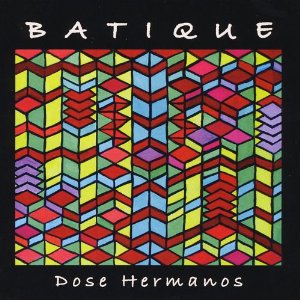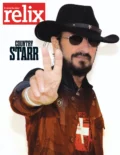
Blame it on the Grateful Dead – why not?
The Dead were the common denominator in Bob Bralove and Tom “T.C.” Constanten’s travels prior to their paths intersecting, after all. Constanten played keyboards with the band from late 1968 through early 1970, packing the charges and lighting the fuses for some legendary performances. (I have two words for you: Live Dead. ‘Nuff said.)
Bralove entered the Dead’s orbit on the other end of things, introducing them to the world of MIDI magic in the late 80s, collaborating with the band both on stage and in the studio.
It was in the wake of Jerry Garcia’s passing, however, that Bralove and Constanten joined forces musically … although perhaps you can blame that on the Dead, too: the need to circle the psychedelic wagons post-Jerry. The pair dubbed themselves Dose Hermanos – brave explorers of the world of keyboard-based improvisational music.
Dose Hermanos’ latest release is Batique – totally let-it-fly performances played on a pair of grand pianos. Batique proves that Bralove and Constanten can get as out there as out there can be, simply using their hearts, souls, and fingers. And to make matters even weirder, the pianos were … well … let’s let Dose Hermanos tell the story.
BR: The two of you have been making music together since …?
BB: We started making music back in 1995 –
TC: And it’s been one long, strange trip ever since. (laughter)
Wouldn’t have it any other way. And that strange trip has usually been plugged in up to this point; this is your first purely acoustic duo project, isn’t it?
TC: Yes – and that’s mainly due to logistics. It’s a lot easier to set up with two electric digital keyboards – and not as easy as you might think to find two grand pianos in the same room. I have seen times where one was this master serious “professional” piano … and the other was, like, this beat-up baby grand that they couldn’t get rid of. (laughter)
But it’s like a matched set of dueling pistols, for instance; they’re very rare to find.
But you found these two beautiful grand pianos at Prairie Sun Recording Studios in Cotati, CA. I know from talking with Dennis McNally that they were in different rooms – were they at least under the same roof?
TC: No – separate buildings.
BB: Prairie Sun was wonderful. It used to be an old chicken farm and they converted the chicken coops into these amazing studios. When you go outside, it still feels like a little farm … very rural – but it’s only about an hour out of San Francisco. A really wonderful, warm environment.
But, yes – the pianos were in different buildings.
So your only connection was by headphones. I mean … the only conventional connection.
BB & TC: Yes! (laughter)
It’s one thing to be recording arranged music under those circumstances, but improvisation is something else. I want folks to realize that once the tape was rolling, neither one of you knew what was about to happen, right?
BB: Right.
TC: But, you know … we’ve been doing this so long that we’ve established many things in the shows and rehearsals we’ve done. Not just cues and clues here and there, but intuitive connections. It’s almost as if we’re reading from the same script; we can see where the flow of the music is going; and we can have the musical equivalent of a conversation, occurring in real time.
Did you swap off pianos during the recording of Batique ?
BB: We did swap off for a little bit, but I think most of the time, Tom was on the Baldwin and I played the Yamaha.
But there was a point where I thought, “I’ve got to put my head to the Baldwin a little bit and Tom’s got to get on the Yamaha … we’ve got to figure out how much of it is the pianos.”
Of course, none of it was. (laughter)
Did you have any ground rules going in?
TC: I think one of the traits we share is a disdain for ground rules. We both like to open up as many doors and windows as possible.
We discovered early on that if you really open yourself up and let yourself go, you’ll find the orientation points and the formula – if anything, you’ll find them better.
BB: We would have a couple of words every once in a while and something might be suggested … but we would often interpret it completely differently. (laughs) But we would never have any kind of musical technical restrictions on it.
There were things like … “Appalachian Summer”, for instance: there were some chord changes that I wanted to make sure we both knew beforehand. We went over them once and that was it. I’d say, “ What if we did this” – and Tom would say, “Got it!”
He heard it once and that was it – “Okay!”
TC: We’ve created sound spaces where we went in with the idea of, “Okay – this is going to be very sparse. No more than five notes at a time and then he’s back.” And you end up with this shimmering curtain … like the stars coming out in the evening.
BB: I like that, Tom. I think we should play that as a piece: “Stars Coming Out In the Evening.”
TC: There we go! (laughter)
That was something I wondered about: if either one of you ever threw a title out to establish a mood – or did the titles come during the playback?
TC: It happened both ways. Sometimes we had something that we used as a point of departure; other times the titles came to us after we played a piece back.
For instance, “Tokyo Dawn” sounded like it was presenting itself to you guys in the moment just as it does to the listener. That Eastern vibe really doesn’t show up until halfway in or so … it truly is like there’s a sunrise happening, but you don’t even know where you are until you have enough light to look around. And then: “Wow!”
TC: That’s what Tokyo’s like –
BB: Yeah!
TC: It’s overwhelming.
BB: And that’s one that came during the playback. Tom and I have played Tokyo – at the end of the show, you’re out on the street and dawn is coming up. You see Tokyo coming alive; both foreign and familiar at the same time.
Every dawn has a quality that’s the same everywhere … but as the light is shed on Tokyo, you know you’re not home. (laughter)
How many sessions altogether to capture these thirteen tracks?
BB: One.
Great – I love that!
BB: We did it all in one day. You know, as producer, you try to make certain energies happen that become part of the recording. To me, that’s part of the reason to go to the acoustic piano: we’ve never done that before; we have an environment that’s different.
Some of our early recordings were in the comfort of my home studio and the electronics were all easy for us and we had unlimited time. But now Tom’s on another coast from me and when we get together, we want to take care of business. We’re at a place where we can as a duo – just sort of go in and say, “It’s time!”
And Tom did make one really wonderful rule as we were recording: he said, “Why don’t we do everything twice as we’re recording them?” It didn’t mean they had to be the same thing –if we decided we were going to go back to something, we would. And if we decided to go somewhere else, we would.
That gave us 26 tracks to choose from – and no edits, by the way.
Did either of you find ideas queuing up in your minds as the session went along? Like, “Ahhh …. not this time; not this take – but for the next one …”
TC: That can be kind of a distraction, actually. I find it’s best if I keep focused in the present time and don’t go in with an agenda; I could easily trip myself up. (laughs)
I try to keep my head as open as possible to whatever shows up.
BB: I’m exactly the same way. I feel like I have to be so present in the interaction with Tom that I have to listen back to even know what happened. (laughs)
It’s like, “Something’s coming at me …” – like you’re driving so fast that you’re just avoiding obstacles and finding the path through the road; you’re not really checking out the scenery. When you listen to the playback you go, “Whoa – that’s what we were thinking?” (laughs)
That’s the thing – I know these songs are basically reactions to reactions to reactions … but, say, on “Here To Their”, for instance, there’s just one chord – bang! – and that’s the gauntlet one of you has thrown down. A totally empty canvas – there’s barely even a canvas.
BB: Yeah! That’s the way it is! (laughs) And you know, I feel like it’s very difficult to pull this kind of performance off until you have the kind of trust that I have with Tom. I know where he’s going; I know he’s going to take whatever I do and lift it up and shine a light through it that will amuse and entertain and fascinate me.
That makes me feel good about whatever I’m doing; it’s this warm, enveloped place to just play and enjoy myself. And that trust opens up all of these possibilities.
And that only comes with time.
BB: Except I have to say there was an immediate connection with us. Yes, the confidence and the trust come with time, but something happened the very first time we played together.
TC: Our first concerts had a couple of rough cuts here and there, but lately every time we go out for an appearance, I’m confident that it could be recorded for a CD.


No Comments comments associated with this post